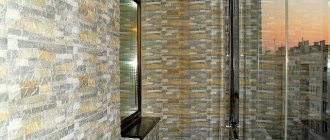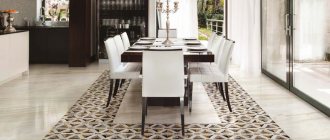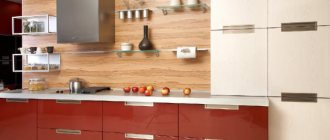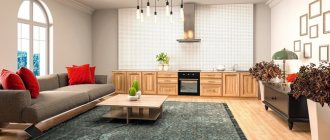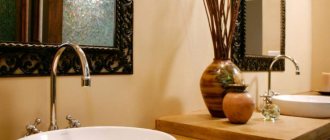Home > Construction > Materials >
Date: 03/25/2021
An important part of the renovation is the choice of material. Many people ask what porcelain stoneware is and whether it is worth using it for a kitchen backsplash. We have prepared information about the structure of porcelain stoneware and its care, explained all the pros and cons, and showed photos of kitchens as examples.
Requirements for a kitchen apron
Whatever apron is chosen, it should be distinguished by:
- resistance to temperature changes;
- immunity to moisture, dust, grease;
- resistance to mechanical damage;
- ease of cleaning.
In addition, the coating should harmoniously match the chosen decoration and furniture, creating an attractive appearance for the entire room.
The material for creating a nice and functional decoration can be anything, especially since modern manufacturers offer a huge selection of a wide variety of wall protection options.
What to choose?
Natural stone, brick, wood, concrete - all these materials, due to their texture, are completely unsuitable for an apron, but without them it is impossible to imagine the loft style. Transparent glass screens solve the problem of relief without hiding their beauty in the least.
A transparent frosted glass screen will slightly smooth out the overly active pattern of a textured wall. In addition, you can place a silhouette pattern and lighting behind it.
Aprons with photo printing are a very common solution for this type of material. They look impressive, holistic and suitable for any style.
A bright plain apron is a less common option; it is used more as an accent, collecting all the decorative details into a single composition.
Ceramic tile
Tiles are such a familiar and convenient way to create a kitchen apron that they still decorate most home kitchen units. Kitchen backsplash tiles have a huge list of advantages. She:
- calmly handles all the troubles of the kitchen: temperature changes, high humidity, splashes of fat and water;
- washes well with plain water and is not afraid of household chemicals;
- durable and aesthetic.
A huge selection of tiles and decorative elements for them allow you to implement any design and use a practical coating for all design styles, from expensive classics to modern minimalism.
The disadvantage of ceramic coating will be the high price of the tile itself and the work involved in its installation.
Simulation of various structures
Porcelain stoneware material is made from mixtures of rocks, the base being clay. Mineral dyes are used to add color.
A kitchen apron made of porcelain stoneware looks impressive in natural shades with a wood texture, or with a mirror surface, which visually increases the space.
The use of stone-like porcelain tiles is popular, and if the kitchen is spacious, do not be afraid to choose dark shades. The production technology of such material is similar to the production of a standard one. However, ceramic tiles for a kitchen or other room are different from porcelain tiles. Therefore, there are several types of porcelain tiles:
- Matte. Perhaps one of the cheapest materials, it does not lose its dignity. Goes well with other coverings, such as wallpaper or plastic inserts.
- Glossy. Of course, backsplash tiles made from this material will not be cheap, but the surface will shine and look beautiful. Most often used as wall tiles, as the material is slippery. Bright, but not provocative colors with a variety of marbled patterns in the kitchen will look best on glossy tiles.
- Semi polished. The peculiarity is that the texture is not completely glossy; small roughnesses appear. The advantage is that during finishing, all seams are joined without problems.
- Glazed. A special product is applied to the tiles - smalt glaze (to protect against damage).
- Satin. The material contains mineral salts, which has a beneficial effect on the biological environment of the kitchen. The size for a porcelain stoneware apron is usually 60x60 cm.
To figure out what type of porcelain tiles to purchase for a kitchen backsplash, you can learn more information about proper installation
Tree
Cozy wood will beautifully fill the kitchen with soft light, pleasant texture, and environmental friendliness. However, the difficulty of maintaining this finishing option does not make it a popular way to decorate a work area.
Wooden panels can dry out or swell; they do not like water and temperature changes, easily absorb dirt and are not very easy to clean. To protect a wooden apron, you will have to use special compounds that extend its service life, and constantly monitor the appearance of the coating. To install the panels, you will have to create additional sheathing, which will “eat up” quite a lot of space. And the price of the coating will not help you stay within the budget finishing range.
Caring for porcelain tiles
Porcelain tiles are quite resistant and are not subject to external influences, micro-scratches, or chips.
But even such a durable product requires care. To ensure that your tiles look new and not worn out during use, you should remember some maintenance rules.
- If we talk about porcelain stoneware, it is less susceptible to contamination. But tile joints, which are not protected in any way, are exposed to an aggressive environment.
- To preserve this material, you should regularly rub them with a protection based on natural or artificial wax. If abrasive substances come into contact with the tiles, it is necessary to clean the surface of the material.
- A porcelain stoneware apron in the kitchen should be wiped as much as possible with a damp cloth or soft brush, because every day the product becomes dirty when preparing food. There are stains that a cloth cannot remove, and in order to clean the surface, you need to use a baking soda solution.
- Chlorine and alkaline preparations will help you remove even the oldest stains.
During the first month of operation, the apron must be washed with an acid solution. This must be done to clean micropores.
Cork
This amazing material is only gaining popularity. The cork apron is characterized by:
- unique appearance and soft charm of natural material;
- durability;
- resilience to climate change;
- antistatic, allowing you to keep the coating clean;
- ease of cleaning;
- absence of mold and other harmful microorganisms.
The disadvantage will be the cost of registration.
In conclusion
A kitchen apron is regularly exposed to negative influences: splashes of water, drops of fat and various products, high temperature, frequent washing. All this makes us look for the most practical and resistant material to all this. Everyone wants the kitchen to be attractive, stylish and harmonious, so another requirement is put forward for the finishing material - a pleasant appearance. In addition to ceramic tiles, there are many other ways to decorate a kitchen working wall: when choosing one option or another, it is important to compare all the pros and cons, think about how the material fits into the kitchen conditions, and only then make a decision.
The article was written for the site.
Tags:Kitchen
Metal
This type of finishing is used quite rarely; it will look best in minimalism or hi-tech. Metal:
- strong and durable;
- easy to care for;
- brings additional lighting and gives visual space;
- not afraid of water, dirt, temperature changes.
Among the disadvantages are the cold appearance and the need for constant cleaning. On a shiny surface, stains of any origin are very visible, which spoils the appearance of the entire room.
Steel surfaces
Steel is ideal for decorating a kitchen in a minimalist, hi-tech or loft style. This apron is an exclusive option. It makes the room stylish, expensive and even somewhat official. Therefore, to give it “warmth” and a homely atmosphere, steel is combined with wood.
The most popular and affordable are stainless steel aprons. There are also copper options, but they are much more expensive. Their texture can be matte, glossy or mirror. In this case, the entire free surface of the working area is covered with a metal sheet, which makes it possible to achieve a monolithic effect without the formation of seams. Special lighting allows you to effectively highlight the apron.
Brick
Brickwork looks very majestic and stylish. It is perfect for all rustic, classic, loft styles. However, it is used very rarely due to its disadvantages:
- reducing the kitchen by a significant brick thickness;
- heaviness of finishing;
- difficulty of care.
The last drawback can be easily corrected by using glass covering the natural material.
Rails for dishes
For high-quality organization of the work area, you can use railing systems. Fastenings are installed in the same way as for decorative plates.
The most commonly used metal suspension systems are made of chrome-plated steel. They look original in any kitchen, and in addition, they allow you to rationally organize free space.
Stone
An apron made of natural stone will look luxurious and elegant. But this is its only advantage. Otherwise he:
- requires the same luxurious frame;
- heavy in weight and perception;
- roads;
- Some types of stone are quite difficult to clean.
Most of these problems can be corrected with artificial stone.
Photos of a kitchen apron will demonstrate a variety of design options, starting with the simplest models and ending with unique design masterpieces.
Aprons are handmade and made from original materials
Do you think that all the best things are made with your own hands? This is true, especially if you have certain professional skills. Just remember that the kitchen apron should be moisture and heat resistant, strong and easy to clean. You already have enthusiasm (since you are reading this section), all that remains is to decide on the materials.
The extraordinary design of the kitchen apron will become the highlight of the interior. Among the materials stand out:
- pebbles or river stones;
- slate paint;
- wine corks;
- laminate;
- mosaic made of broken glass;
- parquet;
- CDs;
- concrete;
- vintage, aged wood.
This concludes our selection of photographs of various kitchen aprons. We look forward to your comments and wish you original ideas, inspiration and successful renovations!
Photo of apron design in the kitchen
Choosing a style
A durable surface can be incorporated into various interior designs. In addition to the floor, apron, sink and countertop, you can make furniture from porcelain stoneware. Designers often use this, for example, on the facade of a kitchen unit. If some of the furniture is made in this form, then it is possible to decorate it in other rooms: in the living room on the top of a coffee table and in the hallway with a similar floor.
The style is often introduced into classic design, hi-tech, loft, modern, country, art deco, Provence.
In the classics, marble or granite colors are used. Which harmonizes well with wooden elements, milling and carved patterns. Classic flooring requires a wooden floor, but it deteriorates due to high humidity and temperature changes. To avoid this, you can install a porcelain stoneware floor that imitates a cut of wood. It will last a long time and will be almost indistinguishable from wooden boards. This option can be used for other styles, for example, Provence, country, eco-style.
For modern design, select products of the same tone, with a glossy, matte finish or with an abstract pattern. It can become the accent of the room. A beautiful design is obtained by making the apron, the center of the floor and one of the walls in the same way. To decorate the walls, original ornaments with combined materials, elements with six corners, and patterns are laid out. For the loft you can make a patchwork panel.
